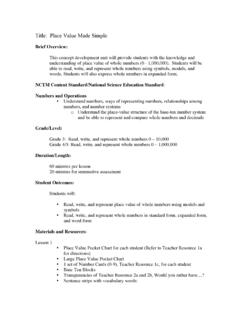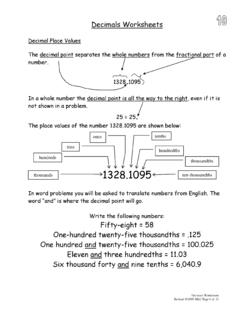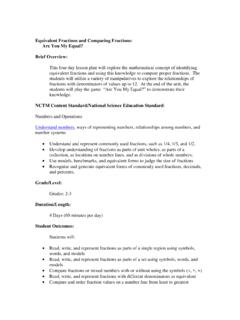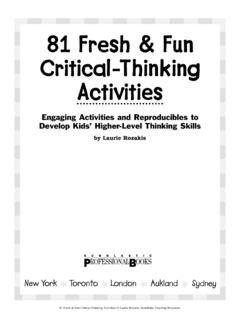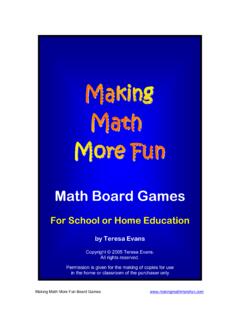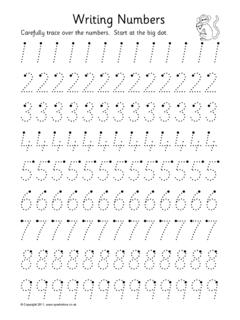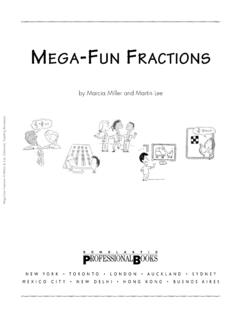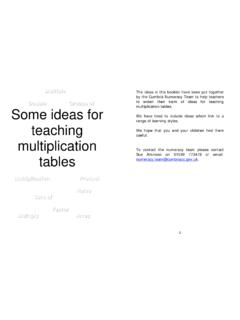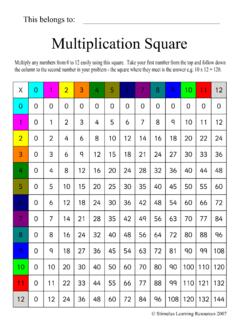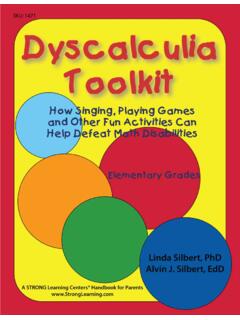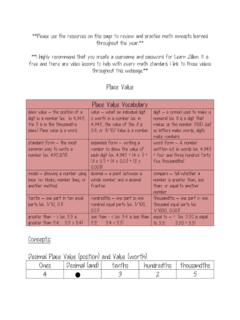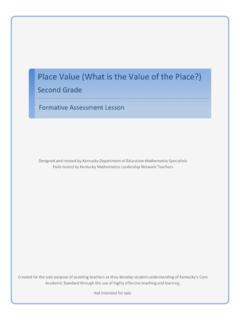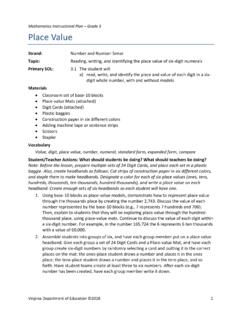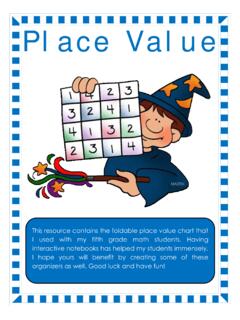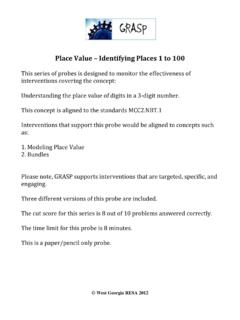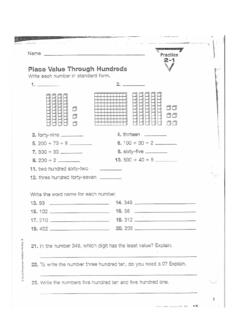Transcription of Place Value Activity Package - Mathematics Shed
1 Place Value Activities Winnipeg School Division Numeracy Project 1 Place Value Activity Package Activities humbly borrowed from various sources. Where possible, sources are acknowledged with the Activity . Package assembled by Manuel Silva Numeracy Project Support Teacher Winnipeg School Division 2005 Place Value Activities Winnipeg School Division Numeracy Project 2 Whole number vertical computational algorithms have negative effects on the development of number sense and numerical reasoning. (Kammi, 1994, Vince Wright 2000) The standard computational algorithms for whole numbers are harmful for two reasons. First, the algorithms encourage students to abandon their own operational thinking. Second, the algorithms unteach Place Value , which has a subsequent negative impact on the student s number sense (Kammi & Dominick, 1998) Place Value is extremely significant in mathematical learning.
2 Yet students tend to neither acquire an adequate understanding of Place Value nor apply their knowledge when working with computational (procedural) algorithms. (Fuson, 1990; Jones and Thornton, 1989) Students associate the Place - Value meanings of hundreds, tens, ones more in terms of order in placement than in base-ten groupings (Bendarnz and Janvier 1982) A major reason for Place Value lapses is the linguistic complexity of our Place Value system in English. For example, we do not name tens as done in some languages ( sixty vs. six-tens ) (Fuson, 1990; English and Halford, 1995) Students with a weak understanding of Place Value have a difficult time understanding will often assume that more digits implies that a number is larger. (Heibert and Wearne, 1986) Many students never master the standard long-division algorithms.
3 Even less gain a reasonable understanding of either the algorithm or the answers it produces. A major reason a underlying this difficulty is the fact that thee standard algorithm (as usually taught ) asks students to ignore Place Value understandings (Silver et al., 1993) As teachers of early years mathematicians we cannot ignore these glaring facts from the research, as well, as our own classroom observations. The time is here to change the way we are teaching students to do math in our classrooms. We need to stop teaching vertical procedural algorithms in our early grades (1-2) and introduce them later on once students have shown clear understanding of Place Value , part-part- whole thinking as well as flexible strategies with whole number computation. This Package is bursting with great ideas that have been created for use by teachers in our Division, to assist teachers in targeting Place Value instruction in an engaging and meaningful way.
4 I would like to thank Manuel Silva for taking the time to compile all the great resources that we as teachers have been creating and you have them all in one Place ! Enjoy using these may not remember all the math you teach them but they will never forget your attitude! Meagan Mutchmor K-8 Mathematics Consultant Place Value Place Value Activities Winnipeg School Division Numeracy Project 3 Some Thoughts on Place Value Place Value understanding plays a key role in the primary grades. It is essential to have a strong foundation in Place Value in order to achieve success in making sense of our number system (based on the digits 0-9), counting, adding multiple-digit numbers, money and many other math skills. For this reason, it is important that Place Value not be taught in isolation for a few weeks but that it be integrated all year long into the math program.
5 In fact, the National Council of Teachers of Mathematics (NCTM) recommends that all Mathematics strands be taught in an integrated fashion throughout the year and not in isolation. When teaching Place Value to students, it is important to be aware of how students developmental levels affect their understanding in Place Value . For example, a student may be able to count to 100 but may not be able to see that 23 is the same as two groups of ten and three ones or 1 group of ten and 13 ones. They may be able to count individ-ual items but have difficulty counting groups of objects. John Van de Walle states in his book, Elementary and Middle School Mathematics : Teaching Developmentally, that counting plays a key role in constructing base-ten ideas about quantity and connecting these concepts to symbols and oral names for numbers.
6 In order to develop Place Value concepts, activities should involve concrete models, practice using Place Value language orally, illustrations and symbols. The activities should focus on one or more of the following three main components of Place Value : grouping activities, giving oral names for numbers and written symbols for the concepts. It is also necessary to help children connect Place Value concepts to real-world situations. Working with numbers around them at school, home and community makes learning meaningful for the students. Jim Martland, et. al, in their book Teaching Framework in Number, outline a three level model for the development of base-ten arithmetical strategies. Level 1: Initial Concept of Ten. The student does not see ten as a unit of any kind. The student focuses on the individual items that make up the ten.
7 Student counts forward or backward by ones in addition or subtraction tasks involving tens. At this level, the student can identify numbers in the range of 1 to 10. Level 2: Intermediate Concept of Ten. Ten is seen as a unit composed of ten ones. The student is dependent on representations of ten such as open hands of ten fingers. The student can perform addition and subtraction tasks involving tens when they are presented with materials but not when presented as written number sentences. Level 3: Facile Concept of Ten. The student can solve addition and subtraction tasks involving tens and ones without using materials or representations of materials. They can solve written number sentences involving tens and ones by adding or subtracting units of tens and one. Place Value Activities Winnipeg School Division Numeracy Project 4 Number Sense and Place Value Development Based on research in Young Mathematicians at Work: Constructing Number Sense, Addition and Subtraction (Fosnot and Dolk, 2001).
8 Early Stages of Place Value Development Number Sense: Steps and Landmarks Develop cardinality (final number said in count is the number of objects in the set) Conservation of number (one-to-one correspondence) Subitization to 5 Part/whole relationships (5 and 1 are parts of 6 because they contribute to the 6) Compensation (other ways of making the same number) Counting on Place Value Student recordings of their work Sporadic drawings with no attempt to represent the quantity One-to-one correspondence in the pictures to the real object Iconic (symbols) representations to represent the quantity of the objects Symbolic representation of the quantity using one symbol (a number) Once students have developed the concepts of cardinality, one-to-one correspondence, part/whole relationships and compensation, they will begin to see the need for an organized way to keep track of their counting, especially of larger groups of objects.
9 They will begin to organize their counting into groups of five or ten. After working with this concept many times, they will begin to understand that ten objects can be represented as one ten. Students need to develop the concept that one group of ten equals ten units within that group. This is called unitizing (using a number to count not only objects but also groups). This must be in Place before students can understand Place Value . They can then start to work with the concepts of making 10s (8 and 2 make 10, 7 and 3 make 10) and breaking numbers apart (26 is 20 and 6 and eventually, 26 + 32 = [20 + 30] + [6 + 2]). Place Value Activities Winnipeg School Division Numeracy Project 5 Subitizing The ability to subitize is a precursor to Place Value understanding. Subitizing is the ability to recognize dot arrangements in different patterns.
10 Since children begin to learn these patterns by repetitive counting they are closely connected to their understanding of the particular number concept. Quantities up to 10 can be known and named without the routine of counting. This can help children in counting on (from a known patterned set) or learning combinations of numbers (seeing a pattern of two known smaller patterns). Young children should begin by learning the patterns of dots up to 6. Students should also associate the dot patterns to numbers, numerals, finger patterns, bead strings, etc. You can then extend this to patterns up to 10 when they are ready. Subitizing is a fundamental skill in the development of number sense, supporting the development of conservation, compensation, unitizing, counting on, composing and decomposing of numbers.
